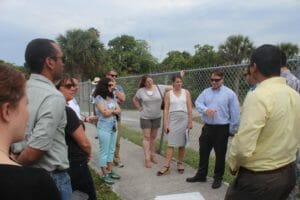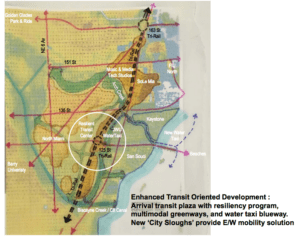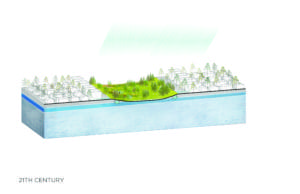Top Story
Date: May 22 – 27, 2016
Location: Arch Creek Basin, Miami, Florida
Sponsor: Miami-Dade County, Florida
Subject Area: Resilience, water management and housing affordability strategies for Arch Creek Basin
Panel Chair: Dave Stebbins, Vice President, Buffalo Urban Development Corporation
Background and Panel Assignment
With over 84 miles of coastline and a population of 2.6 million people, Miami-Dade County is one of the most vulnerable areas to sea level rise in the country. Many parts of the County are already regularly experiencing flooding due to low elevations and drainage problems, and the County is vulnerable to extreme weather events that could include catastrophic winds and storm surge. South Florida’s porous substrate also makes traditional defenses, such as levees, less effective for managing groundwater levels and flooding.
 Miami-Dade County invited ULI to study the Arch Creek Basin area, a multi-jurisdictional area which comprises approximately 2,838 acres and four municipalities, as well as unincorporated County land. The area is economically diverse and includes sites which have experienced repetitive losses due to routine flooding. The area is also likely to experience development and change, as a future commuter rail station will provide an opportunity for transit-oriented development.
Miami-Dade County invited ULI to study the Arch Creek Basin area, a multi-jurisdictional area which comprises approximately 2,838 acres and four municipalities, as well as unincorporated County land. The area is economically diverse and includes sites which have experienced repetitive losses due to routine flooding. The area is also likely to experience development and change, as a future commuter rail station will provide an opportunity for transit-oriented development.
Arch Creek Basin’s challenges and vulnerabilities are characteristic of other areas of the County, and therefore solutions developed during the panel could have wide applicability. The site also can serve as a model for resilience planning due to its designation as an Adaptation Action Area, a policy tool developed to address interrelated climate change risks more holistically.
Questions posed by the sponsor included:
- Given that the study area is a drainage basin, how can water best be moved and managed?
- Considering that many neighborhoods in the study area were built on low-lying sites or constructed using “dredge and fill” policies, what opportunities exist to incrementally move towards a more sustainable development pattern?
- How can housing affordability concerns be addressed alongside flood risk concerns? Could redevelopment improve access to quality affordable housing?
- How can community vulnerabilities to tropical storms be addressed and what policies can be put in place to reduce disproportionate impacts?
- What opportunities exist to implement more sustainable design and land use for the area around the proposed commuter rail station?
- What capital improvements, operational improvements and green infrastructure investments are needed to make the area more resilient?
- How should the county, multiple cities, and other taxing authorities best manage implementation and funding of a plan for this multi-jurisdictional drainage basin?
Summary of Recommendations
The panel proposed a long-term vision that would increase the resilience and preparedness of Arch Creek Basin, enhance social equity, and create opportunities for all of Arch Creek Basin’s residents. The panel’s recommendations fall into four main categories:
- Building social resilience in the community, especially among vulnerable populations;
- Encouraging a more resilient and connected development pattern at the future transportation hub on high ground;
- Managing water by restoring some of Arch Creek Basin’s historical, natural systems; and
- Using the Adaptation Action Area framework to address governance, financing, and implementation
 Building Social Resilience
Building Social Resilience
Social inequity is a major problem in Miami-Dade County, and climate change is likely to further exacerbate the economic and opportunity divide. Social resilience must therefore be a priority for Miami-Dade County in climate action planning, and community groups and low-income residents need to be actively engaged in planning efforts. Miami-Dade County is already home to many active community and civic groups focused on addressing climate change and supporting populations of all income levels. The panel recommends leveraging this civic infrastructure to enhance social resilience, especially among the more vulnerable populations within the Arch Creek Basin. Neighborhood climate workshops, information dissemination in multiple languages, and resident participation on the Adaptation Action Area Steering Committee would address social equity in building community resilience. As part of a longer-term, more capital-intensive effort, the panel recommends building a Resilience Resource Center that can serve as a support center and gathering place year-round and a recovery assistance center after storms or floods.
Encouraging a More Resilient and Connected Development Pattern
A critical panel recommendation is the development of higher-density housing along the Coastal Ridge, especially at the proposed transit site. The panel strongly supports the construction of the Tri-Rail Coastal Link and transit station at NE 125th Street, which could then support a transit-oriented development (TOD), designed to be an exemplar of resilient development and include housing for the vulnerable. As well as providing greater mobility for study area residents, the transit station provides a logical location for housing on high ground, within downtown North Miami and along NE 125th Street. This new development should be designed to be mixed use, walkable, and mixed income, creating a unique sense of place and economic development opportunities for downtown North Miami. Beyond market-rate residential, office, and retail uses, a new mixed-use development hub must provide affordable housing options for low-income and vulnerable populations within the Adaptation Action Area, particularly those living on at-risk sites. Social equity and affordability must be considered from the conception of the TOD development project, putting funding and policies in place to ensure long-term affordability for owners and renters. This new housing could offer an attractive and safer option for those choosing to relocate from frequently flooded parts of Arch Creek while keeping families within their communities. In fact, those choosing to relocate from vulnerable parts of Arch Creek Basin should receive first right of refusal on the affordable units integrated into the TOD. Over the long term, the relocation of residents from flood-prone sites to a new, high-ground site would enable land assembly needed to create new green spaces.
Managing Water and Restoring Natural Systems
Arch Creek Basin is naturally configured to collect, absorb, and manage floodwaters, and the most flood-prone areas follow the historic contours of the land in the lowest-lying areas. The panel recommends both restoring some of Arch Creek’s historic function and implementing short-term, smaller-scale water management actions. Household-level efforts, such as using rain barrels, capturing roof runoff, and increasing the tree canopy, can help improve social cohesion and green space within vulnerable communities while better managing rainfall. Longer-term actions that could partially restore the natural flows of the Arch Creek Basin should be coupled with approaches to allow relocation of flood-prone properties and residents. The signature long-term action is the creation of a largescale park, the “city slough,” that would allow increased flood storage, minimize flood-pump dependency, and create new, active recreation areas. The slough would be implemented over time in concert with the alternative safe housing strategy, through the acquisition and assembly of persistent flood-prone properties. The panel also recommends protecting coastal properties through the construction of “mitigation atolls” in Biscayne Bay that would provide some buffering against storm surges while enhancing stormwater storage and water quality functions.
Implementing a Pilot Adaptation Action Area
The Adaptation Action Area framework provides a unique opportunity to implement large-scale resilience planning efforts across jurisdictional boundaries, with Arch Creek Basin serving as a pilot for southeast Florida. The panel recommends using the Adaptation Action Area framework for the Arch Creek Basin by establishing an Adaptation Area Steering Committee within the South Florida Regional Planning Council. This steering committee should include representation from all municipalities within the adaptation area as well as individual local residents. The panel further recommends that comprehensive and capital plans for all the municipalities in Arch Creek Basin be amended to conform to the action area recommendations. To generate the resources to implement the panel’s recommendations and other resilience needs within the Adaptation Action Area, the panel recommends starting with locally available channels, including the development of a robust capital plan, as recommended by the MiamiDade Sea Level Rise Task Force. Funding from the North Miami Community Redevelopment Agency (CRA), creation of new Community Development Districts for flood-prone coastal properties, and creation of a land assembly fund to assist with acquisition of flood-prone properties should also be explored.
